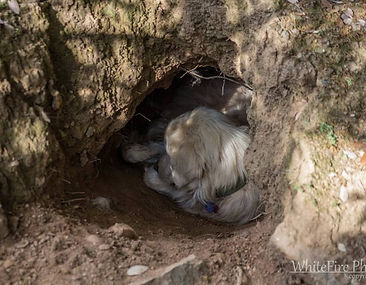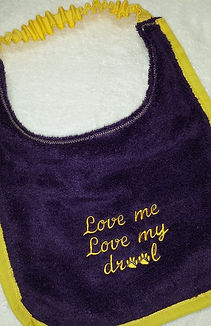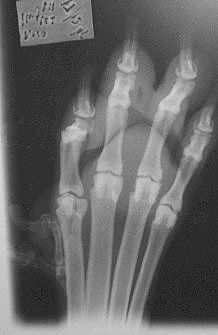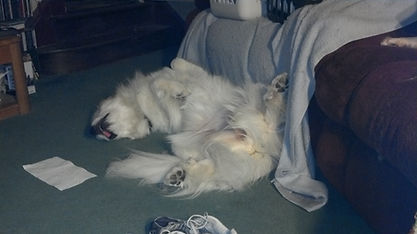Pyr Facts
[aka ~ So You Think You Want a Pyr?]
Bred to guard flocks of sheep and goats among the steep slopes and high valleys of the Pyrenees Mountains, the Great Pyrenees is a law unto himself. An independant thinker, the Great Pyrenees is not a breed for the first-time dog owner.
One of the most frenquent comments from first -time Pyr owners on the multiple Facebook groups dedicated to the breed is 'I knew that they [bark, dig, shed,drool, etc] but I didn't know it was THAT MUCH'. No matter how prepared you think you are, the reality is almost always beyond any image conjured by the mind of the novice Pyr owner.
~ Pyrs are considered a 'Giant Breed'. This means that that adorable 15-20 pound, 9 week old fluffy puppy that you just picked up from the breeder will grow into a 80-140 pound dog in 1-2 years.

<-- Before you know it, this..... will transform into this -->
The change is inevitable. If you aren't prepared to accept that, please consider a smaller breed that may be more suited to your lifestyle.

~ Pyrs DIG. A Pyr and a perfectly manicured expanse of fescue and Kentucky bluegrass DO NOT MIX.
If you are the kind of person who weeds their lawn with a pair of tweezers, perhaps a parakeet is the pet for you. Yes, this hole is bigger than the norm, even for a Pyr, but it just goes to show the extremes that some Pyrs will go to. [Thank you Debi Carpadus of WhiteFire Photos for these great pics of your LGD Willie and his amaing excavation!]


~ Pyrs BARK. Bred to guard, whether you need guarding or not, a Pyr will alert you to all threats real and imagined within a 3 mile radius. While this trait cannot be completely trained out of a Pyr, there are numerous techniques to minimize the disruption to the peace and quiet of your neighborhood. Invisible. Ninja. Squirrels. Just sayin'.
~ Pyrs ROAM if not confined by a sturdy fence. A Pyr off leash is a DIS-A-PYR. You might think that you have trained a Pyr to never leave your side, but they have simply lulled you into a false sense of security. Given the opportunity, a Pyr will explore and patrol the entire neighborhood. A fenced yard [NOT an invisible fence*] is a must for a Pyr, and all walks need to be on lead with either a well-fitted collar or harness. A Pyr should not be tied out on a tether. They need freedom of movement to perform their job, and tethering can lead to health and behavioral issues. If you want a pet that stays put, get a rock.
*While an invisible fence may keep most dogs in, it does nothing to keep other dogs and wildlife out of the designated area. A Pyr that is determined to cross that invisible line won't care about that little shock, and may be seriously injured by it. Furthermore, once whatever caused him to cross the line is dealt with, he may be unwilling to cross back over.
~Pyrs GUARD. Livestock, children, your yard, the cat, your six year old's ferret, they aren't picky. It's what they were bred for, and they take their job seriously. They have even been known to 'claim' random children who stop to pet them, to the point that parents attempting to retrieve said children must be cautioned to call the child to them, rather than approach. A parent running forward in a panic at the sight of their precious offspring, so close to the giant white monster rolling over for a belly rub, may be seen by the Pyr as a threat to the child. [Barley, a male from our August 2013 Raia x Petty litter, guards sheep and chickens in New Jersey.]
Because of their natural empathy, many Pyrs make outstanding Therapy dogs and even Service dogs. They are instinctively drawn to nurture and protect young or injured animals, regardless of species, and are naturally solicitous of the elderly or infirm. There are reports of Pyrs adopting and guarding orphaned lambs and even fawns and other wild animals.

~ Pyrs SHED. Constantly. This can be controlled somewhat by weekly brushing. They also 'blow coat' seasonally, releasing all of their undercoat over a short period of time. Males typically once a year, females once or twice a year depending on their heat cycle.
Forget ever wearing black clothes again. Buy stock in a vacuum cleaner company. On the up side, some particularly artistic or ambitious Pyr owners spin their Pyr's fur into yarn and knit or crochet lovely sweaters, shawls, scarves etc.
It is important to note that a Pyr should NEVER be shaved unless it is medically necessary. In Summer that long white coat reflects the sun and protects the skin from sunburn, while air flow through the coat cools the dog. In Winter the thick undercoat insulates the dog and keeps him warm. In many cases a shaved coat never grows back correctly.
[Photo courtesy of the Great Pyrenees Club of Greater Chicago]

~ The DROOL. Most Pyrs have a tight lip, and do not drool. Those that do drool are not as bad as some other breeds, but it does happen.

~ One of the Pyr's most defining characteristics is their double dewclaws on the rear legs. In many breeds the dewclaw is vestigal, and no longer serves any purpose. In Pyrs, the dewclaw is attached by tendon, muscle and bone. Removal weakens the total structure of the leg. A Pyr's dewclaws should NEVER BE REMOVED. Removing a Pyr's dewclaws would be the equivalent of cutting off your own thumb. More than one novice Pyr owner has called their breeder, freaking out at the sight of those dewclaws moving independantly!

~ Pyrs are SMART. Don't let that lazy attitude fool you. Pyrs are far smarter than they let on. They are also nortoriously STUBBORN. Unlike Labradors or Golden Retrievers, Pyrs are not motivated by a desire to please. Training a Pyr requires a different approach. A Pyr in the Obedience or Rally ring is a rare sight, and a testament to the deep bond and respect between Pyr and Handler.
~ Pyrs are BEAUTIFUL. Even an 'ugly' Pyr. It is IMPOSSIBLE to see a Pyr and not want to pet it. It is a law of nature, so get used to being the center of attention when out in public with a Pyr. In 1675 Louis XIV declared the Great Pyrenees the Royal Dog of France, and these noble dogs don't let you forget it. Total strangers will walk up and start petting your Pyr, without so much as a by-your-leave. Children will run up and throw their arms around his neck. [Not a good thing if your Pyr is wary of strangers.] To quote a certain animated film ~ "He's so FLUFFY!"
~ Pyrs are generally HEALTHY. The average lifespan of a Great Pyrenees, given regular care, is 10 years. One lovely Pyr celebrated her 16th birthday at the GPCA National Specialty in April 2014! Some of the most common health conditions encountered are ~
~ Osteosarcoma. Recent studies suggest that delaying Spay/Neuter until after age 2-3 years, when the growth plates are closed, may reduce the risk of Osteosarcoma, while still reducing the risk of other cancers. Also, a promising vaccine has been developed that notably extends the post-amputation lifespan of Pyrs who have lost a leg as part of their treatment for Osteosarcoma.
~ Hip Dysplasia/Degenerative Joint Disease. This malformation of the hip joint varies in degrees of severity. PennHIP is the preferred protocol for assessing hip joint quality in Great Pyrenees, though OFA protocols can be used as well.
~ Elbow Dysplasia
~ Allergies. Some Pyrs benefit from grain-free diets. Others show a sensitivity to chicken. A high quality kibble diet, or an appropriate raw diet, is generally sufficient to avoid the most common food allergies.
~Pyrs can be sensitive to anesthesia. Due to their slow metabolism it takes longer for seditives and other medications to take effect, leading vets to administer a larger amount than is necessary. Seek out a vet who is familiar with giant breed dogs, or who is open to learning about them. With improvements in anesthesia this is less of a problem than in the past, but you are still your Pyr's best advoate.
~ PYR QUIRKS. Every breed has it's foibles, those little things that make their owners smile, shake their heads or throw their hands up in surrender. Pyrs are no exception. These are just some ~
~ The PYR PAW PAT. Delivered whenever they want something and you aren't getting the telepathic message. Ever so gentle, but impossible to ignore. This guaranteed attention getter isn't applied to just humans. A Pyr will use it on other animals as well.
~ Flipping Food Bowls. Food just tastes better off of the floor, rather than from a dish.
~ Sleeping Upside Down. That ungracefull sprawl, all four feet akimbo and their dignity thrown to the wind. Pampered Show Champion, spoiled Companion or dedicated Working dog, they all do it.
~ The Burp. Just a little burp, but they do it right in your face. It is like they are making a comment on whatever you are saying or doing at the moment.
~ The Immovable Object. Time to get off the couch? Go outside? Go into the crate? Rather than doing what you want, some Pyrs perfer to become the immovable object, rolling over onto their backs and refusing to budge. They also seem particularly fond of 'sleeping' in front of doors, preventing you from leaving the room or house, or opening the fridge.
~ Invincible. Look up the word 'stoic' in the dictionary and you will see a picture of a Pyr. Pyrs are seemingly immune to pain. If a Pyr shows signs of being in pain then they are in PAIN.
~ Nocturnal. Don't be surprised if your Pyr decides to take the Night Watch. Many are the predators, both four legged and two legged, that stalk the darkest night.
